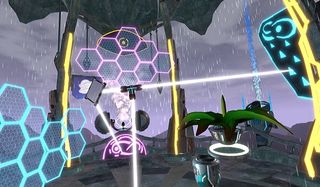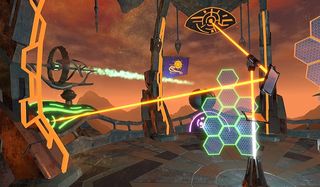Symphony Of The Machine PSVR Review: Missing A Few Notes

The world is a barren wasteland and your job is to return life to this parched landscape. In Symphony of the Machine, you'll achieve this goal by taking part in the ancient, highly spiritual practice of strapping a VR headset to your face and solving puzzles in order to nurture potted plants.
Recently launching for PlayStation VR and the Vive, Symphony of the Machine is one of those VR games that takes a played-out mechanic and makes it interesting all over again simply by plugging it into a virtual space. While bending beams of light to solve puzzles is by no means a new concept in 2D games, Starfire Studios proves that you really can teach an old dog new tricks with a light, atmospheric, puzzler that unfortunately ends a bit too abruptly and suffers from a handful of technical issues.
The first thing you'll notice upon booting up Symphony of the Machine is that the game is super easy on the eyes. You'll find yourself standing alongside a campfire in a beautiful desert with nothing to guide you save a few mysterious hieroglyphics and a rather impressive metal tower looming in the distance.
Make your way to the tower and you'll locate the room where all of the gameplay of Symphony of the Machine unfolds. In short, there's a beam of light shooting out of the ground and continuing on into the heavens. You're soon presented with a mirror, which you can use to direct the light into panels that change the world's weather from rain to sun, wind or clouds.
The trick here is that activating one panel will cause a barrier to appear elsewhere in the room, blocking another.
So why are you lighting these panels? To create certain weather patterns to nurse a bunch of plants back to life, of course.

Each plant in the game represents a set of puzzles. The plant will display what weather conditions it needs to grow. Complete all of its tasks and the plant will blossom, opening up the next plant's worth of puzzles and actually springing into life across that formerly barren wasteland below.
CINEMABLEND NEWSLETTER
Your Daily Blend of Entertainment News
After you get past the first plant, subsequent puzzle sets will require more and more environment manipulation. A plant might require rain and wind, for instance, or sunshine, clouds and rain all at once. As you get deeper into the game, you'll be gifted with a second mirror and two splitters to give you more lighting options. Remember how I said that lighting a panel also creates a barrier? Well, that's the whole hook of the game. As the tasks become more complicated, you've got to figure out how to use the 3D space and your limited set of tools to bounce light around the room and illuminate the necessary panels while avoiding those barriers.
Things get a little more complicated about five plants deep, with condition lenses being added into the mix that let you add a heat or cold element to your light beams. Shine a beam into rain with a cold lens in the mix, for instance, and you'll get snow.
My first issue with Symphony of the Machine is easily its most forgivable, and that's the game's length. Virtual reality gaming is still very new territory for developers, so I've kind of gotten used to these short games that are -- let's face it -- basically glorified tech demos. Symphony's crop of puzzles is only about seven plants, though each plant requires a handful of conditions to be created before it blooms. Even muddling about and taking my time to enjoy the scenery, the game clocked in at about two hours.
That time would have been quite a bit less if it wasn't for my big gripe with the game, and that's the technical issues that frequently made an otherwise relaxing, intriguing experience into a frustrating mess.
Playing with the Move controllers and PSVR, you move around the game world by pointing at a location and warping to it. You can't carry items with you, however, which means getting a mirror from Point A to Point B was a task in and of itself. There's a hovering bot that is supposed to assist in these efforts, carrying one item for you as you move around the room. Unfortunately, the little guy has a mind of his own and I'm fairly certain he was programmed to torment me.

Sometimes he would hover behind me and, no matter which way I turned, he'd stay to my back, making it damn-near impossible to grab that mirror he was supposed to be holding for me. A couple times he seemed to get stuck in the ground's geometry, bumbling about down low until he finally found a way to escape and return to me. Sometimes, no matter how much I yelled at him to "get the hell over here" (not a game mechanic so much as an act of desperation) he would simply hang out across the room, ignoring me. He'd also occasionally grab an item I was trying to use to direct a beam of light or, worst of all, continue to hover just out of my reach. No, seriously, I'd reach for the item the little bugger was holding and it would hover just out of the way. I'd blindly take a step in that direction (VR helmet, remember) and he'd continue to avoid my grasp. Symphony of the Machine is supposed to be about creation and all I wanted to do was grab a pipe and destroy my little "helper."
To be clear, I tried adjusting and even turning off the lights in the room and varied my distance from the camera and the issues persisted.
What's most frustrating is that, when Symphony of the Machine was working correctly, I really enjoyed myself. The task of solving these types of puzzles in a new type of environment was a lot of fun, and the game's visuals and a lovely, atmospheric soundtrack complemented it nicely. Sometimes I'd head back down the tower just to stand out in the open, look up and enjoy a windy rainstorm.
Thankfully, these are the kind of issues that can probably be patched out of a game, and I certainly hope Starfire Studios continues to polish Symphony of the Machine until it shines. It's pretty short and got extremely frustrating for me at times, but I think there's a solid VR experience that just wasn't quite ready for prime time.
This review based on a PlayStation 4 download of the game provided by the publisher.
Staff Writer for CinemaBlend.
Most Popular




